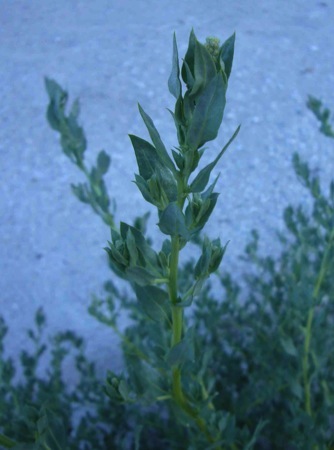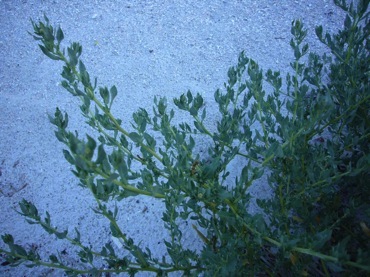Atriplex cristata: Pigweed by the Sea

Beach Orache Crested Salt Bush
Anyone familiar with the Goosefoot family will see the Beach Orache and presume it is probably edible, and it is.
A distant cousin to the Chenopodium, the Atriplex is an Old and New World plant that wasn’t used much by the Natives Americans though elsewhere in the world it has a long history of feeding folks. The east coast Indians apparently ignored it for the most part, though the west coast Indians used it.
Atriplex cristata, said AT-ree-plex kriss-STAY-tuh, is one of a large genus whose leaves and seeds are eaten around the world. More than two dozen Atriplex are edible, and probably more. Atriplex is the ancient named used by Pliny for the orache, also know as A. hortensis. Cristata means crested. It has also been called A. pentandra (pen-TAN-druh) which means with five antlers, or in this case five stamens.
A. cristata can be found on the coast from Texas to New Hampshire. But Mainers don’t fear, A. glabriuscula runs from your coast north to Greenland. It’s also in the Great Lakes area down through Indiana to Kentucky. It is also found in Alberta, Canada. An import no doubt. In fact, an Atriplex can be found in all areas of North America except Arkansas, Tennessee and Nunavut Territory in Canada. The leaves and seeds of the following species have been used in North America: A. argentea, A. californica, A. canescens, A. confertifolia, A. coronata, A. elegans, A. lentiformis, A. nuttalii, A. patula, A. serenana, and A. truncata. Locally we also have A. pentandra. Also eaten is A. halimus and A. semibaccata, the latter common in Australia but naturalized in North America. The Hopi Indians used the ashes of the A. canescens as baking powder, and the roots of the A. californica can used as a substitute for soap.
Closely related to the beet and spinach, there are no member of the Atriplex genus that toxic, but, not all are palatable. And in the “I didn’t know that” category meat from sheep that graze on Beach Orache has high levels of vitamin E.
Green Deane’s “Itemized” Plant Profile

Beach Orach Crested Salt Bush
IDENTIFICATION:
An annual or perennial, sprawling to erect, much branched and clump-forming, six inches to 1.5 feet tall. Stems obtusely angled, leaves attach to the main stem or have a short stem, alternate or opposite, oblong, oval or slender-elliptic .5 to 1.5 inches long, silvery scurfy underneath; often curling upward. flowers in short, dense, naked terminal spikes, usually yellow, seeds reddish brown.
TIME OF YEAR:
In warmer climes nearly year round, in northern climes summer into the fall.
ENVIRONMENT:
Sandy beaches, keys, mainland Florida, a costal plant for most of its range.
METHOD OF PREPARATION:
Leaves cooked like a green (reduces), minute seeds cooked, added to soups and stews or ground. Some say the leaves and seeds can be eaten raw. The seeds perhaps but I find the leaves too bitter to eat raw.

